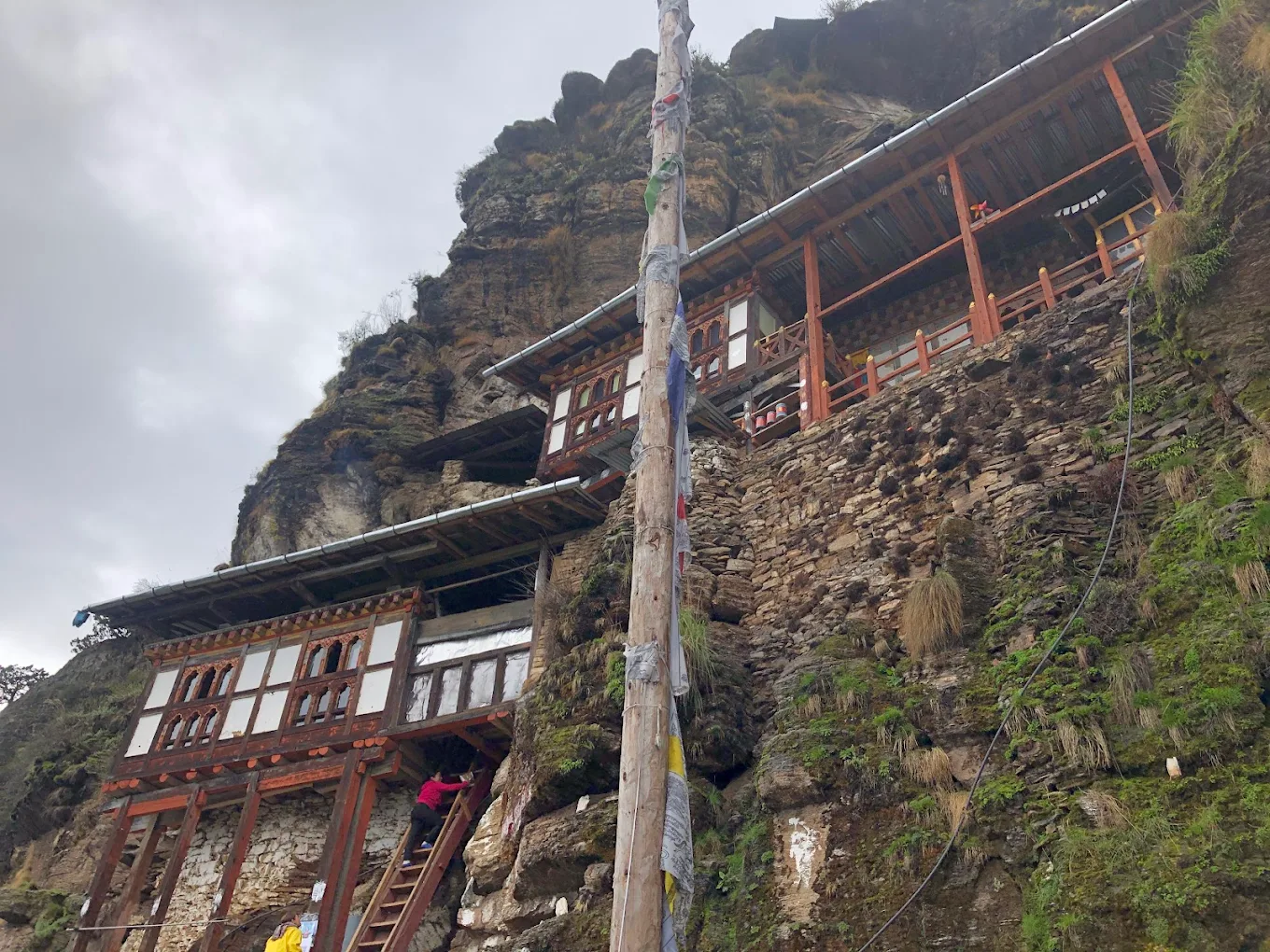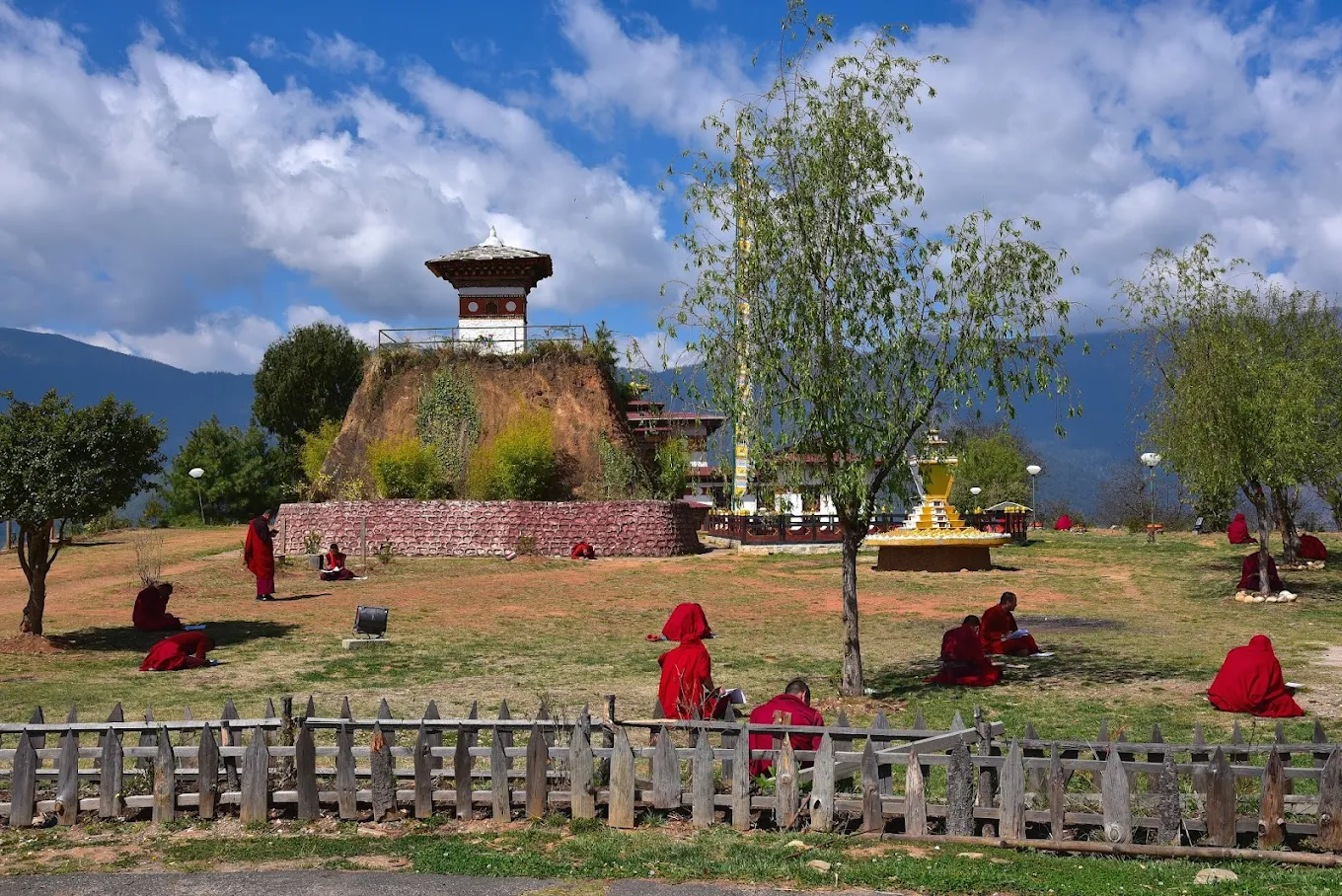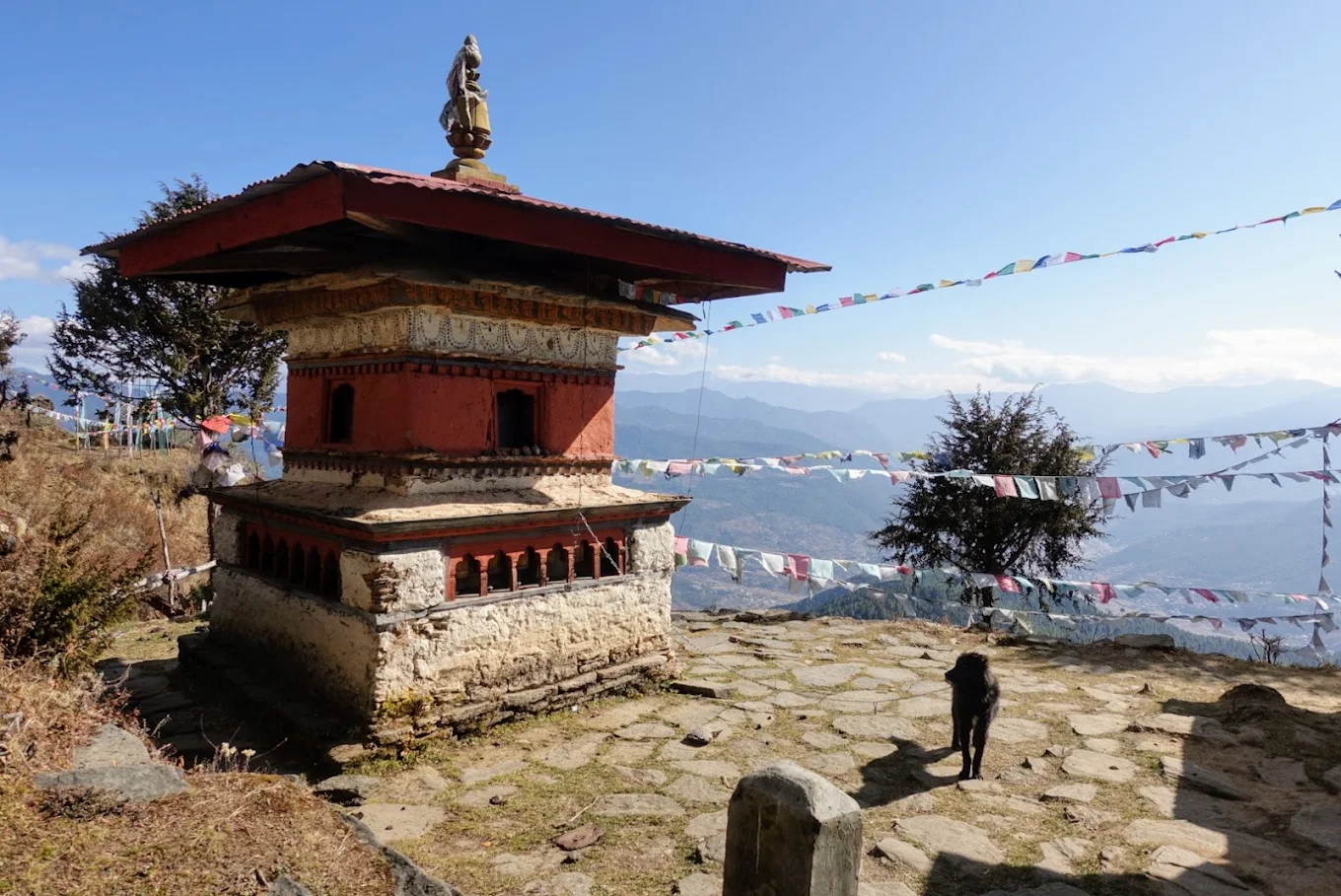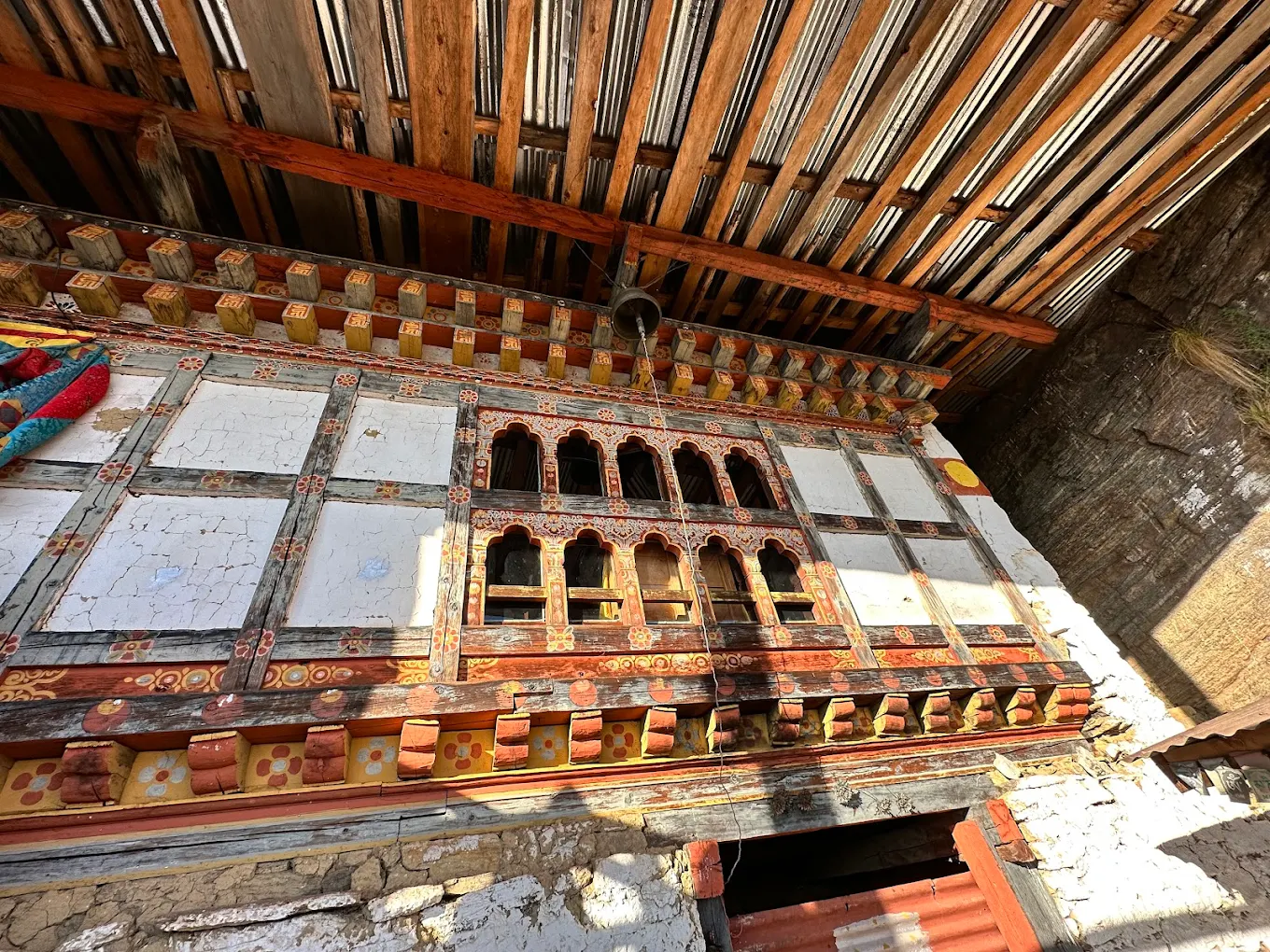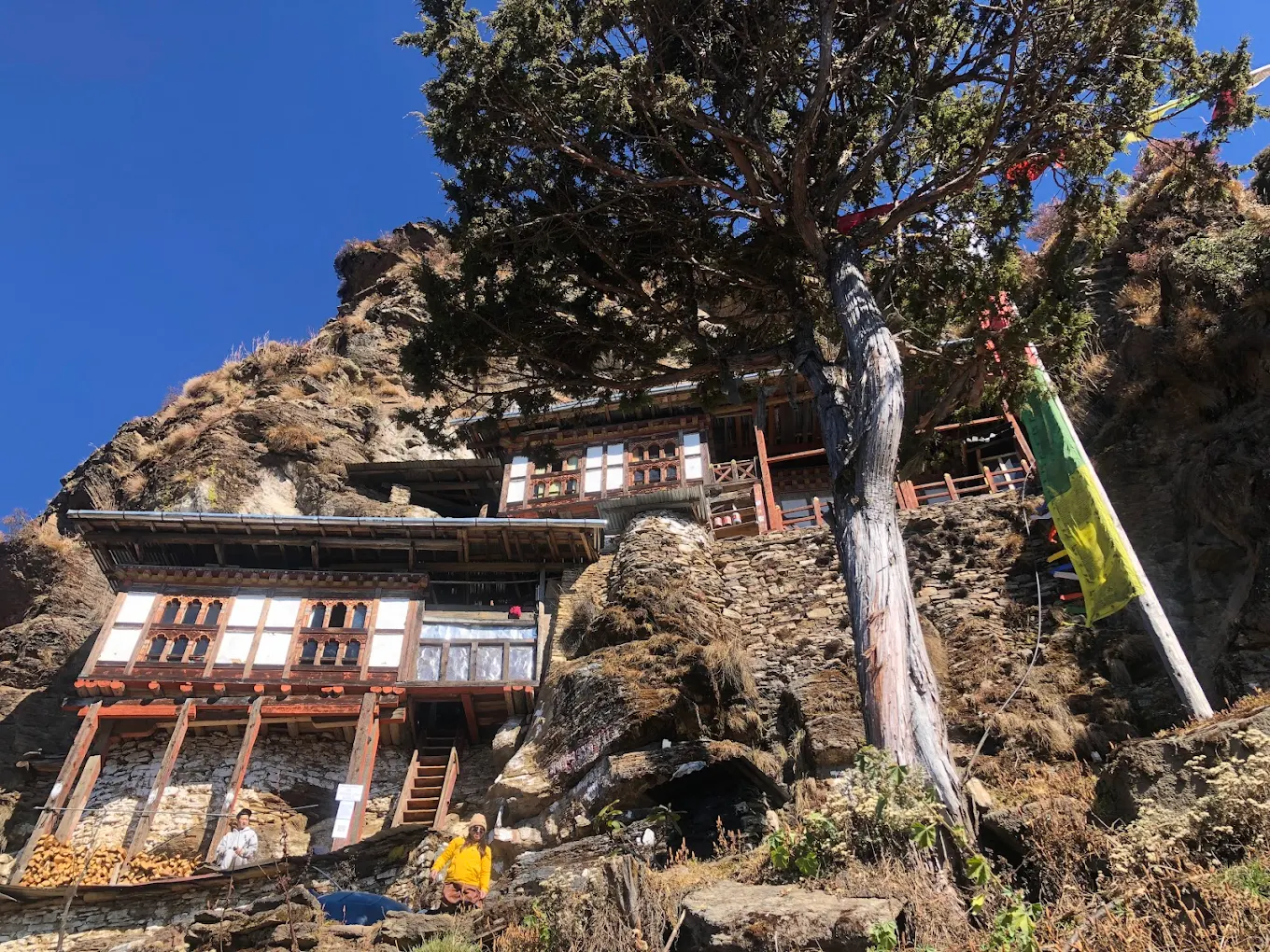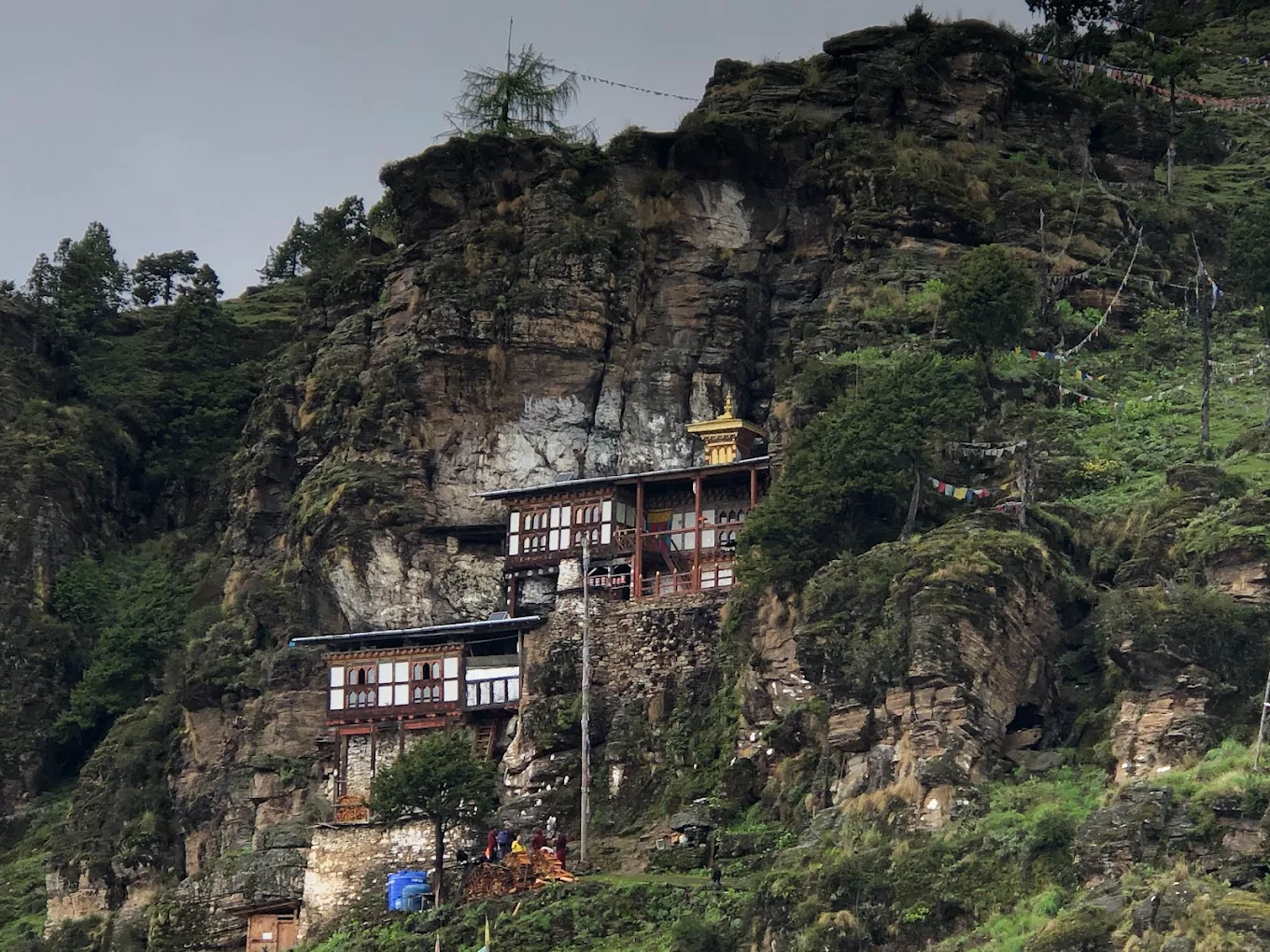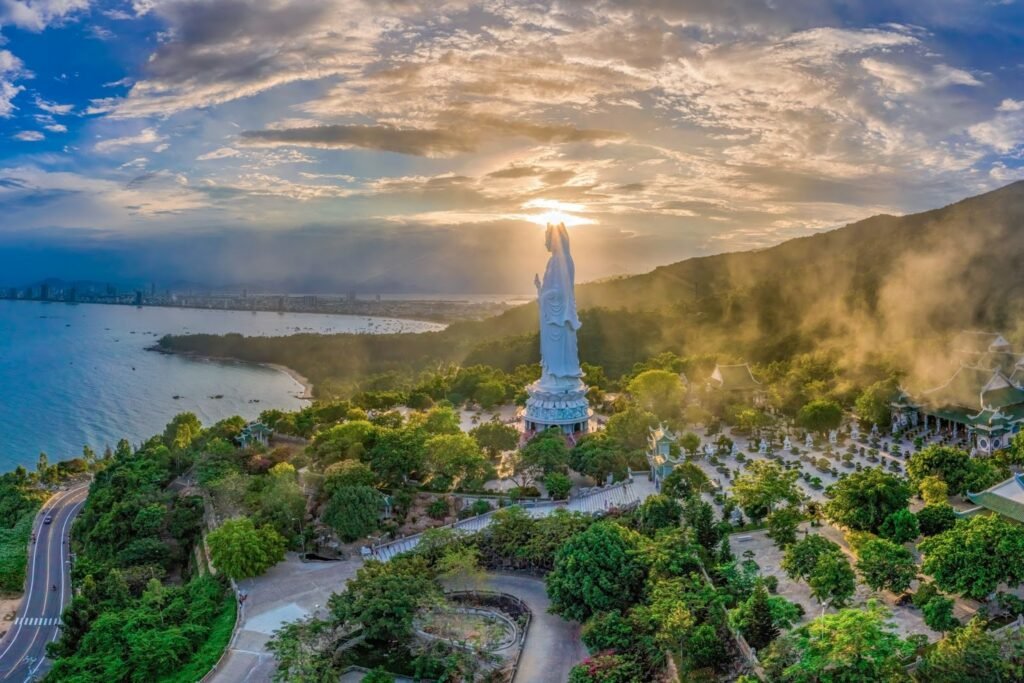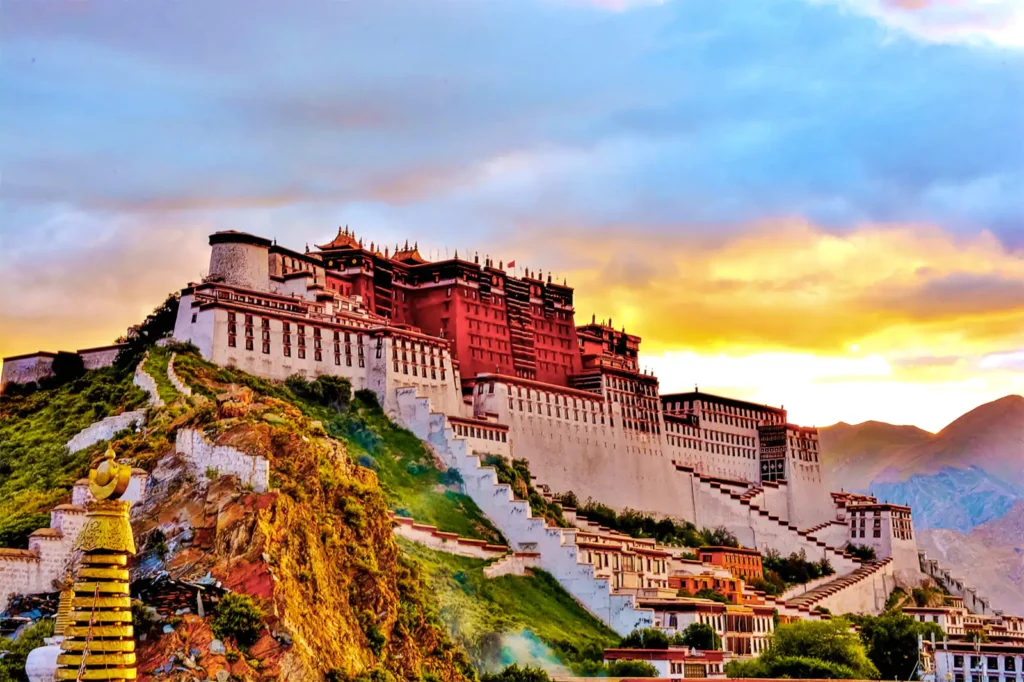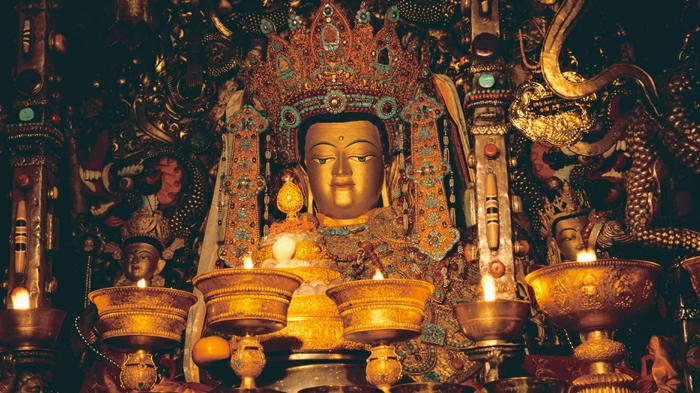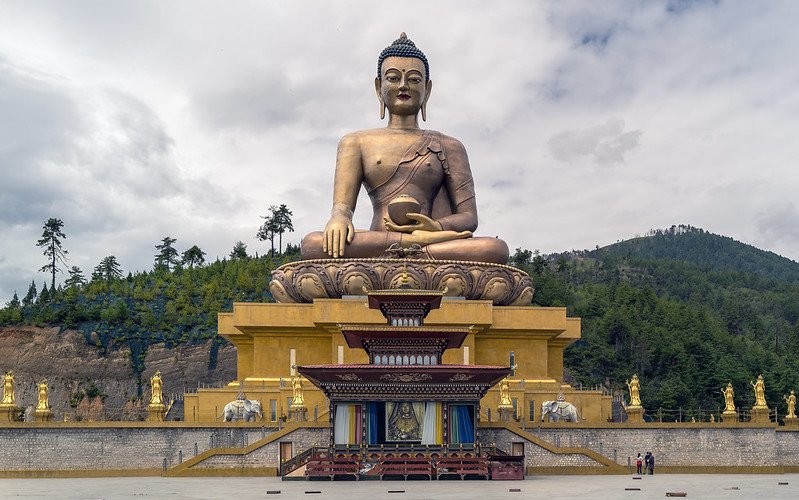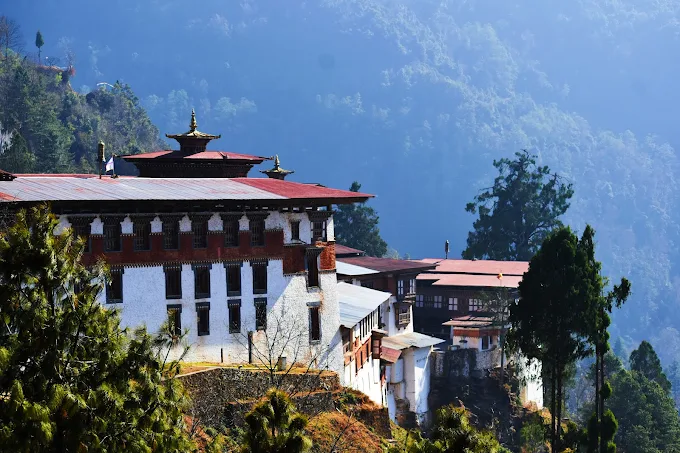Bumdrak Monastery: Sacred Cliff of Paro’s Nyingma Legacy
As dawn spills over Paro Valley’s rugged peaks, Bumdrak Monastery clings to a cliff at 3,800 meters, its whitewashed walls catching the first light above Sang Choekhor. Within, a bronze Guru Rinpoche (Padmasambhava) rests beside Shakyamuni Buddha and Dorje Phagmo, their forms framed by colorful murals and yellow mentsi curtains, as butter lamps flicker against a rock etched with 100,000 dakini footprints. During Tshechu, prayer flags dance in the alpine breeze, masking the chants of masked dancers honoring Nyingma’s ancient lineage. Blessed by Guru Rinpoche and Khandro Yeshe Tsogyal in the 8th century, this temple, known as the “Cave of a Hundred Thousand Prayers,” draws pilgrims along the Bumdrak Trek, its sacred caves echoing celestial blessings. Perched above Taktsang Monastery, it weaves meditation and myth, offering a sanctuary where Bhutan’s Nyingma spirit soars amid snow-capped vistas.
Overview and Significance
Bumdrak Monastery, perched above Paro Valley, stands as a Nyingma pilgrimage site, its cliffside halls and dakini relics embodying 8th-century sanctity. This temple weaves devotion, legend, and alpine serenity, anchoring Bhutan’s spiritual heritage.
Introduction to Bumdrak Monastery
Bumdrak Monastery, also called Bumdra, rises at 3,800 meters in Paro’s highlands, its white walls and chorten a beacon of Nyingma Buddhism, Bhutan’s oldest school, rooted in Dzogpachenpo teachings. Blessed by Guru Rinpoche in the 8th century, it bears the name “Rock of One Hundred Thousand Footprints,” where 100,000 dakinis left their marks, as recounted in legends of Khandro Yeshe Tsogyal’s miracles. A key stop on the Bumdrak Trek, it draws Sharchop and Paro pilgrims, its caves and statues fostering meditation. Overlooking Taktsang Monastery, it offers a glimpse into Bhutan’s Nyingma soul.
Historical Journey
The monastery’s story unfolds across centuries:
- 8th-Century Blessing: Guru Rinpoche and Yeshe Tsogyal meditated here, consecrating the dakini cliffs.
- Early Legacy: Became a retreat for Nyingma lamas, tied to Paro’s sacred sites.
- Pilgrimage Role: Grew as a trek destination, linked to Taktsang’s sanctity.
- Modern Continuity: Maintained by caretakers, drawing trekkers and devotees.
Cultural Significance
The monastery shapes Paro’s spiritual landscape:
- Nyingma Nexus: Transmits Dzogpachenpo, guiding meditation.
- Community Hub: Tshechu unites Paro’s pilgrims and trekkers.
- Mythic Symbol: Dakini footprints mark its sanctity.
Unique Legacy
Its dakini relics and Dorje Phagmo statue define Bumdrak’s sacred identity.
Community and Global Impact
- Local Bonds: Hosts rituals, binding Paro’s Sharchop community.
- Pilgrim Draw: Attracts Bhutanese and global trekkers.
- Cultural Note: Inspires Nyingma pilgrimage traditions.
Historical Anecdotes
- Yeshe Tsogyal’s dakini miracles drew early pilgrims to the cliffs.
- Trekker tales recount serene nights under Bumdrak’s starlit skies.
Social Role
Ceremonies and meditations knit spiritual and social threads.
Artistic Influence
Its murals inspire Paro’s thangka artisans.
The monastery’s history shapes its form, where cliffs and chorten frame a space of reverence.
Architectural and Spiritual Features
Bumdrak Monastery’s small temple and vibrant murals blend Nyingma austerity with Bhutanese craft, its dakini rock a sacred anchor. This section unveils its design and relics.
Iconic Design
The monastery’s whitewashed stone walls, topped with a wooden roof, cling to Paro’s cliffs at 3,800 meters. Its courtyard, dotted with prayer flags, overlooks snow-capped Himalayas, with a chorten marking the sacred site.
Key Structures
- Main Prayer Hall (Lhakhang): A small chamber with colorful murals and altars.
- Chorten: A golden stupa, a meditative focal point.
- Sacred Caves: Nearby cliffs bear dakini footprints.
- Caretakers’ Hut: A modest shelter for resident monks.
Worshipped Statues/Deities
- Guru Rinpoche: A bronze statue honors Nyingma’s founder.
- Shakyamuni Buddha: A central icon depicts enlightenment.
- Dorje Phagmo: An emanation of Yeshe Tsogyal, the main relic.
Materials and Techniques
Stone walls and timber beams, with mineral-pigment murals, reflect Bhutanese artistry.
Signature Elements
The dakini footprint rock and Dorje Phagmo statue define the monastery’s sanctity.
Lesser-Known Features
- Mentsi Curtains: Yellow drapes protect ancient murals.
- Prayer Flags: Adorn cliffs, carrying aspirations skyward.
Preservation Efforts
Caretakers maintain murals against Paro’s alpine dampness, preserving woodwork.
Environmental Integration
The cliffside perch ties the monastery to Paro’s rugged peaks, a serene retreat.
Artisan Narratives
Paro painters crafted murals, blending Nyingma iconography.
Symbolic Details
Dakini footprints signify celestial blessings; chorten evokes purity.
Landscape Integration
Himalayan views enhance meditative calm, grounding the monastery.
These spaces cradle the monastery’s rituals, inviting pilgrims into Nyingma’s meditative heart.
Rituals and Practices
Bumdrak Monastery’s rituals, rooted in Nyingma’s Dzogpachenpo, blend chant and contemplation, fostering enlightenment. This section explores its ceremonial pulse.
Daily Sacred Rites
- Sutra Chanting: Caretakers recite Nyingma texts at dawn.
- Offerings: Butter lamps and incense honor Guru Rinpoche.
- Meditation: Dzogchen sessions focus on innate wisdom.
Unique Practices
Pilgrims meditate in dakini caves during Tshechu, seeking celestial blessings.
Festival Traditions
- Tshechu: In October, masked dances honor Yeshe Tsogyal.
- Losar: New Year prayers bless Paro’s pilgrims.
Visitor Engagement
Guests may join chants or meditate in caves, guided by caretakers.
Spiritual Community Roles
Caretakers lead rites; Paro villagers support festivals.
Interfaith Connections
Exchanges with Kagyu monks near Taktsang reflect harmony.
Ritual Symbolism
- Butter Lamps: Light signifies wisdom.
- Prayer Flags: Colors balance elements.
Seasonal Variations
Tshechu intensifies in autumn; winter retreats deepen meditation.
Monastic/Community Life
Caretakers meditate; villagers tend the courtyard.
These rituals guide visitors to the monastery’s philosophical depths.
Visitor Information
Bumdrak Monastery welcomes travelers to Paro’s cliffs, offering practical details to engage with its sacred core.
Navigating to Bumdrak Monastery
Above Sang Choekhor Buddhist College in Paro Valley, a 3–4-hour trek via Chhoe Tse Lhakhang leads to the monastery’s chorten, 22 km from Paro town.
Address of Bumdrak Monastery
Paro Valley, Paro District, Bhutan
Visiting Hours and Etiquette
- Hours: Open daily from 7:00 AM to 5:00 PM, extended during Tshechu.
- Etiquette: Dress modestly; remove shoes in the prayer hall; no photography inside.
Transport Options
- Car: A 30-minute drive from Paro to Sang Choekhor, then trek.
- Trekking: 3–4-hour hike from Sang Choekhor, guided with ponies.
- Bus: Paro-Sang Choekhor buses, then trek.
Accessibility and Safety
- Accessibility: Steep trek limits access; courtyard is flat.
- Safety: Paro is safe, but carry water and warm clothing for altitude.
Amenities and Surroundings
No permanent restrooms; nearby campsites offer tea during treks.
Immersive Tips
Visit in October for Tshechu dances or meditate in dakini caves.
Nearby Cultural Experiences
- Taktsang Monastery: 1–2-hour descent, Bhutan’s iconic cliffside temple.
- Sang Choekhor College: 3–4-hour trek back, a Nyingma learning hub.
Photography Tips
Frame the chorten with Himalayas at sunrise; respect altar restrictions.
The monastery’s gates open to its Nyingma philosophy, where myth and faith unfold.
Cultural and Spiritual Insights
Bumdrak Monastery’s essence lies in its Nyingma roots and Paro’s spirit, offering insights into Bhutan’s sacred depth.
Religious Philosophy
Nyingma’s Dzogpachenpo teaches innate wisdom, guiding pilgrims to liberation.
Environmental Spirituality
Paro’s cliffs reflect nature’s sanctity, a Nyingma value.
Artistic Symbolism
Dorje Phagmo’s statue embodies Yeshe Tsogyal; dakini rock signifies divinity.
Community Resilience
The monastery uplifts Paro’s pilgrims, fostering devotion.
Environmental Stewardship
Villagers plant pines, honoring Bhutan’s eco-ethos.
Meditative Practices
Dzogchen sessions cultivate clarity, open to trekkers.
Cultural Narratives
Dakini legends inspire Tshechu tales, binding Sharchops.
Historical Context
The monastery ties to Paro’s 8th-century Nyingma spread.
These insights weave a reflection on the monastery’s enduring presence.
Conclusion
Bumdrak Monastery shines as a sacred cliff of Paro’s Nyingma heritage, its dakini footprints and Dorje Phagmo statue a testament to Guru Rinpoche’s 8th-century blessing. Tshechu’s masked dances and Dzogchen meditations pulse with wisdom, weaving serenity into Paro Valley’s highlands. From its chorten to sacred caves, it fosters enlightenment amid Himalayan peaks. As a pilgrimage beacon, it bridges Bhutan’s mythic past with its vibrant present, inviting travelers to pause where prayer flags whisper timeless devotion.
